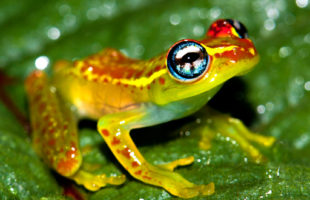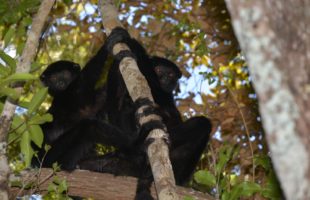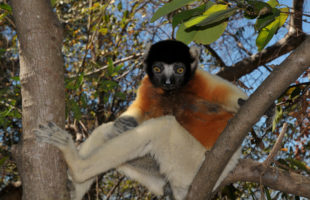They are the unofficial mascots of Madagascar and probably the most famous Malagasy lemurs: The ring-tailed lemurs (Lemur catta). Their portraits grace the logo of Madagascar National Parks (MNP), countless t-shirts, and company emblems. A full-grown ring-tailed lemur weighs maximally 3.5 kg. The ringed tail is 60 cm longer than the whole body which is only 40-45 cm. In contrast …
LesenSchlagwort-Archiv: Lemurs
The fruit gourmets: Black-and-white Ruffed Lemurs
Many people know them from zoos and animal parks: Black-and-white ruffed lemurs (Varecia variegata). Besides Red Ruffed Lemurs and the Indri, they belong to the largest lemurs with a head-torso length of 40 to 60 cm, an additional 60 cm added for the tail. Weights of 3 to 4 kg are the average. Black-and-white ruffed lemurs exclusively live in the …
LesenDie singenden Lemuren: Indris
Ihre Gesänge gehören zu den eindruckvollsten, die die Tierwelt zu bieten hat: Man kann die Stimmen der Indris (Indri indri) kilometerweit durch den Wald schallen hören, und sie tragen eine eigentümliche Traurigkeit mit sich. Angeführt und begonnen wird der Gesang stets vom Elternpaar einer Familie, das damit sein Revier absteckt, aber auch mit anderen Familien kommuniziert und vor Bedrohungen wie …
LesenMitsinjo reserve
Mitsinjo: Mitsinjo means as much as “looking ahead” or “planning the future”. Location: The reserve is located close to the village Andasibe in eastern Madagascar, around 140 km away from the capital Antananarivo, in the region Alaotra-Mangoro. You drive approximately four hours on RN2, which is not in the best condition, and then change direction at a well-signed junction. Information …
LesenThe left-handed lemurs: Coquerel’s sifakas
With their typical teddy bear-like appearance, they wrap many travellers around their fingers: Coquerel’s Sifakas (Propithecus coquereli) wear a plush, snow-white fur, whereby the upper sides of the arms and thighs as well as the chest are deeply chocolate brown colored. With up to a half meter head-torso-length – in addition, another half meter tail – as well as approximately …
LesenThe angels of the forest: Silky sifakas
The Silky Sifaka (Propithecus candidus) is one of the most beautiful and special lemurs of Madagascar, but also one of the rarest. There are only about 250 sexually mature silk sifakas left in Madagascar, otherwise they do not occur anywhere else in the world. For comparison: In Asia alone there are still around 3000 to 5000 full-grown specimens of tigers …
LesenThe rarest lemur on Earth: Perrier’s Sifaka
Practically the counterpart to the white Silky Sifaka is the closely related Black Sifaka or Perrier’s Sifaka (Propithecus perrieri). With a height of 85 to 92 cm and a weight of three to six kilograms, it belongs to the larger lemurs, with the tail accounting for up to 46 cm of its total length. Suitably to the name these animals …
LesenSecret kings of the North: Golden crowned sifakas
In an incredibly hot, dry and inaccessible area in north-eastern Madagascar live white lemurs, which owe their name to the golden fur on their heads: the Golden Crowned Sifakas (Propithecus tattersalli). The secret kings of the north reach a height of just 95 cm with a weight of 3.5 kg, whereby still further 45 cm of tail come in addition. …
LesenWidely spread, hardly researched: Crowned Sifakas
In the northwest of Madagascar live lemurs, which occur quite frequently, but are nevertheless hardly researched: The Crowned Sifakas (Propithecus coronatus). Their habitat is limited by the two rivers Mahavavy in the southwest and Betsiboka in the northeast. Today, however, there are indications that the species is much more widespread and also populates areas around Tsiroanomandidy, Amboloando (south of Miandrivazo) …
LesenNo life without the Ocotillo: Verreaux’ Sifakas
The Verreaux’ Sifakas (Propithecus verreauxi) lives in the south of Madagascar and belongs to the few lemurs that successfully colonize the hot and hostile spiny forests. It is a very adaptable species that can survive even in very small forest areas. It can even be found in some lowland rainforests in the southeast of the eighth continent. In the northwest, the …
Lesen MADAMAGAZINE Your Magazine about Madagascar
MADAMAGAZINE Your Magazine about Madagascar










